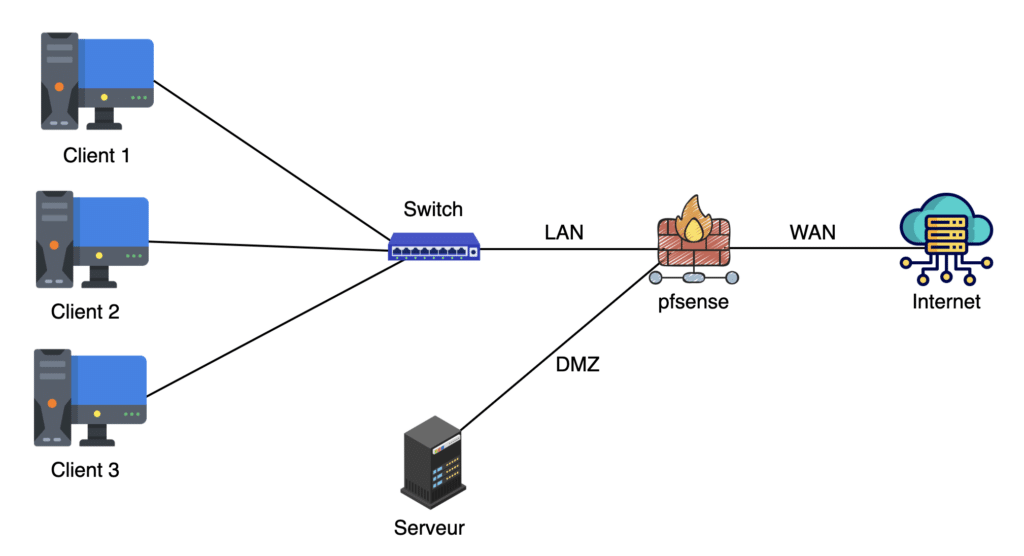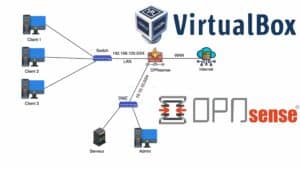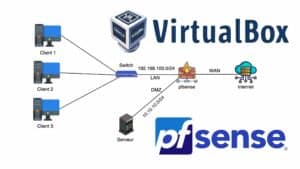In the world of network security, pfSense stands out as a versatile open-source firewall. It offers robust protection and advanced routing and traffic management features. But how exactly does pfSense work in your network? In this article, we explore the crucial role of pfSense and its positioning in a network architecture. This will give you a better understanding of its impact and usefulness in your infrastructure.
What is pfsense?
pfSense is an open-source operating system based on FreeBSD. It is specially designed for use as a firewall, router and VPN access point.
pfsense acts as a security barrier between your internal network and the Internet. To protect your systems against online threats.
Its main objective is to :
- Protect and secure networks by filtering incoming and outgoing traffic;
- By monitoring and controlling network communications;
- Offering advanced features such as support for ;
- Bandwidth management, and much more.
pfSense vs OPNsense: What’s the difference?
Key features of pfsense
As a firewall, pfSense offers a range of essential functions:
Firewall: pfSense acts as a firewall by inspecting. And by filtering network traffic according to user-defined rules. This blocks unauthorized access and protects the network against attacks.
NAT (Network Address Translation): pfSense uses NAT to translate internal IP addresses into public addresses when communicating with external networks. This provides an additional layer of security by masking internal IP addresses.
VPN (Virtual Private Network): pfSense supports VPNs. This enables users to create secure, encrypted connections between different networks or remote devices. This guarantees the confidentiality and security of data as it travels over the Internet.
Bandwidth management: pfSense lets you control and limit the bandwidth available for certain applications or users. This optimizes network performance and prevents congestion.
Traffic Monitoring: pfSense offers network traffic monitoring tools that enable administrators to monitor bandwidth usage, identify bottlenecks and detect suspicious network activity.
Where does pfsense fit into a network architecture?

pfSense can be positioned at various points within a network architecture. This is based on the specific needs of the environment and safety objectives.
Here are some typical places where pfSense can be deployed:
Between the local area network (LAN) and the Internet (WAN)
This is the most common location for pfSense. It acts as a firewall between the organization’s internal network and the Internet, filtering incoming and outgoing traffic to protect the internal network against attacks and threats from the Internet.
Between different network segments
pfSense can be deployed to separate different network segments within an organization. These include corporate networks, production and development networks, and customer and employee networks. This makes it possible to control and limit communication between the various segments for reasons of security and confidentiality.
As a VPN access point
pfSense can be used as a VPN access point to enable remote users to connect securely to the organization’s network from external locations. This enables employees to work remotely and securely, and to access the company’s internal resources.
As a virtual private network (VPN) gateway
pfSense can be deployed as a VPN gateway to connect multiple remote sites via a secure VPN tunnel. This enables the creation of a secure virtual wide area network (VPN) between different geographical locations, facilitating communication and resource sharing between sites.
Conclusion
By understanding the role and positioning of pfSense in your network, you’ll be better prepared to take advantage of its features. To reinforce security, manage traffic and provide secure access to your internal resources.
Explore how pfSense can be integrated into your network architecture and discover how it can improve the security and efficiency of your infrastructure.
With pfSense at your disposal, you have a powerful ally to protect and manage your network efficiently and intelligently.
FAQs
What are the advantages of pfSense over other commercial firewalls?
pfSense offers a robust and flexible firewall solution at a lower cost, thanks to its open-source nature. It is highly customizable, and benefits from a large support and development community. And offers features comparable to, or even superior to, many commercial firewalls.
What are the hardware requirements for running pfSense?
pfSense can run on a wide range of hardware, including dedicated devices, virtual servers and desktops. Hardware requirements depend on the expected workload and the functionalities used. In general, however, pfSense can operate effectively on relatively modest hardware.
How do I install pfSense?
pfSense can be installed from an ISO image downloaded from the official pfSense website. You can therefore install pfSense on a physical device or on a virtual machine, such as VirtualBox or VMware.
Is pfSense suitable for small businesses?
Yes, pfSense is suitable for small businesses thanks to its flexibility, ease of deployment and advanced security features. It can be used to secure local networks. To manage bandwidth, provide secure VPN access and much more.
Does pfSense offer technical support?
Yes, pfSense also offers technical support via paid subscriptions, which include software updates, priority access to support and consulting services. However, pfSense also benefits from a large online community offering free support via forums, wikis and mailing lists.



